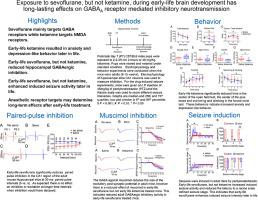Neuroscience ( IF 2.9 ) Pub Date : 2021-08-09 , DOI: 10.1016/j.neuroscience.2021.08.001 Daisy Lin 1 , Jinyang Liu 2 , Alizna Florveus 2 , Vanathi Ganesan 2 , James E Cottrell 2 , Ira S Kass 1

|
Understanding the different mechanisms associated with different anesthetic targeted receptors is critical towards identifying accurate long-term outcome measures as a result of early-life anesthetic exposure. We examined changes in GABAA receptor mediated neurotransmission by a predominately GABAA receptor targeted anesthetic, sevoflurane or a predominately NMDA receptor targeted anesthetic, ketamine. Postnatal day 7 male mice were exposed to sevoflurane or ketamine and examined as adults for changes in inhibitory neurotransmission and its associated change in induced seizure activity. Paired pulse stimulation experiment showed that early-life sevoflurane treated mice had significantly less hippocampal CA1 inhibition later in life. There was significantly increased CA1 excitatory output in the sevoflurane treated group compared to the no sevoflurane treated group after the GABA agonist muscimol. Similar to our previously established data for early-life sevoflurane, here we established early-life ketamine administration resulted in neurodevelopmental behavioral changes later in life. However, muscimol did not produce a significant difference on the excitatory CA1 output between early-life ketamine group and saline group. While sevoflurane treated mice showed significantly higher induced seizure intensities and shorter latency periods to reach seizure intensity stage 5 (Racine score) compared with no sevoflurane treated mice, this phenomenon was not observed in the ketamine vs. saline treated groups. Early-life sevoflurane, but not ketamine, exposure reduced GABAergic inhibition and enhanced seizure activity later in life. The results indicate that early-life exposure to different anesthetics lead to distinct long-term effects and their unique pathways require mechanistic studies to understand induced long-lasting changes in the brain.
中文翻译:

在生命早期大脑发育过程中接触七氟醚,而不是氯胺酮,对 GABAA 受体介导的抑制性神经传递具有持久影响
了解与不同麻醉剂靶向受体相关的不同机制对于确定早期麻醉剂暴露导致的准确长期结果测量至关重要。我们检查了 GABA A受体介导的神经传递的变化,主要是 GABA A受体靶向麻醉剂七氟醚或主要是 NMDA 受体靶向麻醉剂氯胺酮。出生后第 7 天的雄性小鼠暴露于七氟醚或氯胺酮,并在成年后检查抑制性神经传递的变化及其诱发癫痫发作活动的相关变化。配对脉冲刺激实验表明,早期七氟醚治疗的小鼠在生命后期的海马 CA1 抑制显着减少。与 GABA 激动剂 muscimol 后七氟醚治疗组相比,七氟醚治疗组的 CA1 兴奋性输出显着增加。与我们之前建立的早期七氟醚数据相似,在这里我们建立了早期氯胺酮给药导致生命后期神经发育行为的变化。然而,muscimol 对早期氯胺酮组和生理盐水组的兴奋性 CA1 输出没有产生显着差异。虽然与未使用七氟醚治疗的小鼠相比,使用七氟醚治疗的小鼠表现出显着更高的诱发癫痫强度和更短的达到癫痫强度第 5 阶段(Racine 评分)的潜伏期,但在氯胺酮与盐水治疗组中未观察到这种现象。早年接触七氟醚(而非氯胺酮)会降低 GABA 能抑制并增强晚年的癫痫发作活动。结果表明,生命早期暴露于不同的麻醉剂会导致不同的长期影响,其独特的途径需要机械研究来了解大脑中诱导的长期变化。虽然与未使用七氟醚治疗的小鼠相比,使用七氟醚治疗的小鼠表现出显着更高的诱发癫痫强度和更短的达到癫痫强度第 5 阶段(Racine 评分)的潜伏期,但在氯胺酮与盐水治疗组中未观察到这种现象。早年接触七氟醚(而非氯胺酮)会降低 GABA 能抑制并增强晚年的癫痫发作活动。结果表明,生命早期暴露于不同的麻醉剂会导致不同的长期影响,其独特的途径需要机械研究来了解大脑中诱导的长期变化。虽然与未使用七氟醚治疗的小鼠相比,使用七氟醚治疗的小鼠表现出显着更高的诱发癫痫强度和更短的达到癫痫强度第 5 阶段(Racine 评分)的潜伏期,但在氯胺酮与盐水治疗组中未观察到这种现象。早年接触七氟醚(而非氯胺酮)会降低 GABA 能抑制并增强晚年的癫痫发作活动。结果表明,生命早期暴露于不同的麻醉剂会导致不同的长期影响,其独特的途径需要机械研究来了解大脑中诱导的长期变化。在氯胺酮与盐水治疗组中未观察到这种现象。早年接触七氟醚(而非氯胺酮)会降低 GABA 能抑制并增强晚年的癫痫发作活动。结果表明,生命早期暴露于不同的麻醉剂会导致不同的长期影响,其独特的途径需要机械研究来了解大脑中诱导的长期变化。在氯胺酮与盐水治疗组中未观察到这种现象。早年接触七氟醚(而非氯胺酮)会降低 GABA 能抑制并增强晚年的癫痫发作活动。结果表明,生命早期暴露于不同的麻醉剂会导致不同的长期影响,其独特的途径需要机械研究来了解大脑中诱导的长期变化。











































 京公网安备 11010802027423号
京公网安备 11010802027423号